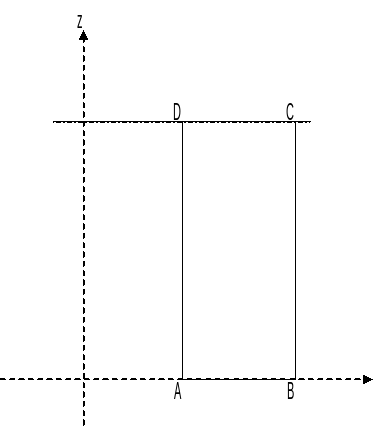28. Z modeling#
This test is exactly the same as modeling A. It allows you to test code coupling in MPI by replacing the thermo-mechanical chain by a weak coupling (without dependence of the thermal on the displacement).
28.1. Characteristics of modeling#
QUAD4 - Axisymmetric

28.2. Characteristics of the mesh#
Number of knots: 4
Number of meshes and types: 1 QUAD4, 4 SEG2
28.3. Tested sizes and results#
Variables |
Moments \((s)\) |
Reference |
\({\varepsilon }_{\mathrm{rr}}={\varepsilon }_{\theta \theta }\) |
\(t=66.666\) |
8.6666 10—4 |
\(t=80\) |
1.1000 10—3 |
|
\(t=90\) |
1.2750 10—3 |
|
\(p\) |
\(t=66.666\) |
0 |
\(t=80\) |
3.0000 10—4 |
|
\(t=90\) |
5.2500 10—4 |
|
\({\sigma }_{\mathrm{zz}}\) \((\mathrm{MPa})\) |
\(t=66.666\) |
—133.333 |
\(t=80\) |
—100,000 |
|
\(t=90\) |
—75,000 |
|
ENEL_ELGA \((J)\) |
\(t=66.666\) |
4.444. 10-2 |
ENER_TOTALE \((J)\) |
\(t=66.666\) |
0.2666 |
ENER_POT \((J)\) |
\(t=66.666\) |
0.2666 |
28.4. Orthotropy (COMPORTEMENT)#
Variables |
Moments \((s)\) |
Reference |
\({\varepsilon }_{\mathrm{rr}}={\varepsilon }_{\theta \theta }\) |
\(t=66.666\) |
8.6666 10—4 |
\(t=80\) |
1.04 10—3 |
|
\(t=90\) |
1.17 10—3 |
|
\({\sigma }_{\mathrm{zz}}\) \((\mathrm{MPa})\) |
\(t=66.666\) |
—133.333 |
\(t=80\) |
—160,000 |
|
\(t=90\) |
—180,000 |